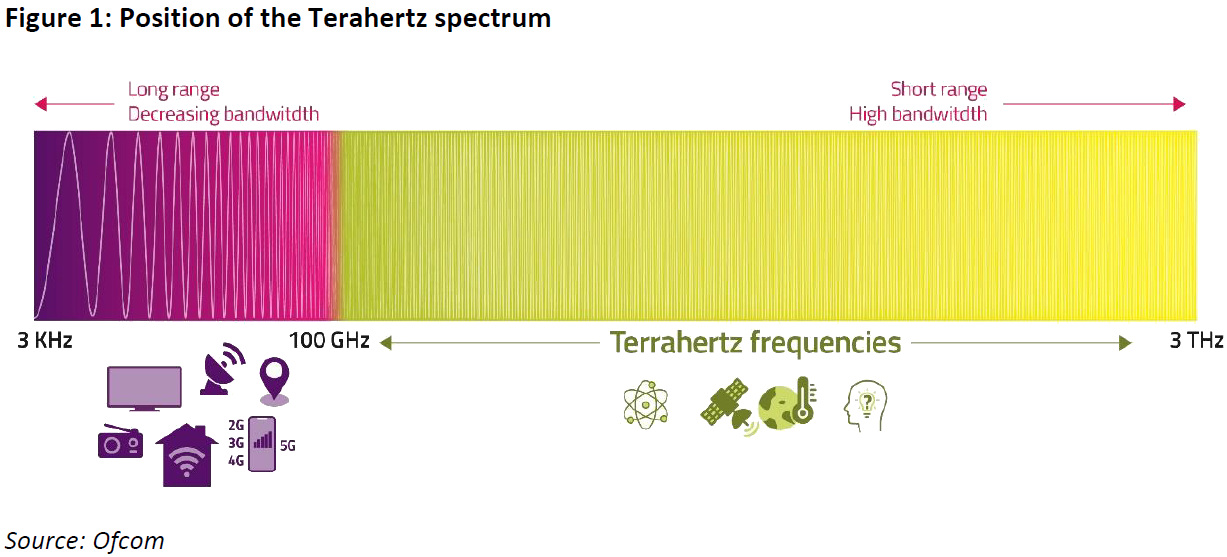Ofcom UK Seeks Views on Using Terahertz Bands for Broadband

Ofcom has today opened a new consultation that seeks feedback on how to maximise the long-term value of Terahertz spectrum, which is expected to play a role in future wireless broadband and mobile broadband (6G) technologies and could deliver speeds of 1 Terabits per second (Tbps) or 1000Gbps (Gigabits).
At present, the regulator states that the Terahertz (THz) range within their interest sits between around 100GHz to 3THz (3000GHz), which is at the very top of the spectrum range currently authorised for use. Such bands are currently used for scientific applications, such as when taking high-sensitivity measurements for weather forecasting and climate change predictions.
However, the early research for a future 6G mobile standard has repeatedly mentioned using the higher frequency THz bands for mobile broadband and point-to-point (line of sight) data links, which is because there’s a huge amount of spare spectrum frequency in such bands for carrying data and that would thus enable significantly faster speeds.
Advertisement
We should add that Ofcom aren’t only considering mobile and wireless broadband connections in their consultation. The document also talks about the potential for use in short range radar devices, other scientific uses, adoption of the bands by satellites in Low Earth Orbit (LEO), indoor data links (e.g. datacentres), vehicle-to-vehicle communications and even nano level communications (including on chip) etc.

We cannot predict which services will become technically and commercially viable (many are still the subject of early academic research) and so it’s important that the spectrum management approach we adopt is as flexible and efficient as possible (in line with our Spectrum Management Strategy).
We think that an approach which adopts spectrum sharing by default could help meet our objectives. Under this approach, users would be granted access on the expectation that ‘their’ frequencies may also be used by others wherever this is possible. We want to foster an environment based on cooperation and collaboration between spectrum users to make this happen.
The rules and approaches to spectrum authorisation that applied at lower frequency ranges should not dictate the way we approach the authorisation and use of this spectrum – given its unique properties and the potential uses being envisaged. New technologies are opening up greater options for sharing. These technologies include careful steering of narrow radio beams; interference cancellation techniques; and sophisticated online platforms and protocols for coordinating spectrum use across different services and users.
We will engage with interested parties to start a national and international dialogue, with a view to maximising the long-term value of Terahertz spectrum while it is still relatively lightly used. We will use our role and voice in international regulatory groups – such as the ITU and CEPT – to encourage greater collaboration and cooperation between different types of emerging spectrum uses in these bands and explore opportunities to use the spectrum more efficiently.
We know the full benefits of this new approach to spectrum management will not be realised overnight. But we also know that missing the opportunity to do things differently from now onwards means those full benefits may never be realised.
All of this may sound good, but there are some pretty significant caveats with this, particularly for mobile networks. In order to understand this, it’s important to remember that lower frequency mobile signals tend to travel further (even though they have less room for data to flow), while higher frequencies do the opposite.
In terms of mobile networks, it’s worth remembering that the latest 5G standard already supports transmission in the millimeter-Wave (mmW) bands (5G operators tend to harness the 20-30GHz range), but this has not been widely adopted because it’s only really useful for very short-range coverage applications (e.g. in a busy public shopping area) – the signals are just too weak to go much further.
Advertisement
As a result, if mobile operators wanted to make a large deployment of mmW 5G then they’d have to spend a huge amount of money to build an extremely dense and complex network, which would only really be viable in dense urban areas. But such links are fairly viable for Fixed Wireless Access (FWA) networks, especially those within a modest Line of Sight (LoS) range.
Suffice to say, most mobile operators have balked at big mmW deployments for 5G and prefer to harness the sub-6GHz bands, which are much more economical. Put another way, since mobile operators have struggled to make a viable case for mmW deployment, then that doesn’t bode well for THz bands, which would be an order of magnitude harder to harness.
Just for a point of reference, LG did recently succeed in transmitting data at a rate of 105Gbps (Gigabits per second) over a single channel using the 300GHz band (here), which ran over an outdoor distance of 100 metres (exceptional work, given the band being used). But this was conducted during perfect weather and with line of sight to the target, so is perhaps more representative of potential FWA than mobile connectivity.
Ofcom are already well aware of this, which is partly why they joined with senior Government MPs and the Institution of Engineering and Technology (IET) earlier this year to help encourage the development of future 6G technologies that prioritised societal benefits – as opposed to the usual focus on delivering “ever higher data [speeds] and ever higher spectrum bands” (here).
Advertisement
The new consultation is thus all about understanding what possibilities and interest there really is in the THz bands, with Ofcom suggesting that future mobile devices might harness it for shorter-range tasks (e.g. user-to-user, user-to-kiosk, user-to-vehicle, vehicle-to-vehicle etc.), although these could easily be achieved with existing wireless technologies in lower frequency bands.
The regulator said they would share the feedback received and “our evolving thinking” in their future Spectrum Roadmap, which they plan to publish in Spring 2022.
Mark is a professional technology writer, IT consultant and computer engineer from Dorset (England), he also founded ISPreview in 1999 and enjoys analysing the latest telecoms and broadband developments. Find me on X (Twitter), Mastodon, Facebook, BlueSky, Threads.net and Linkedin.
« Netomnia UK Expands Gigabit Broadband Rollout into Wales






















































Why haven’t they given us citizen broadband radio? Ofcom looked into it when of course America started doing it, then they flat out forgot about it. Cynical me thinks they thought hmmm give people license free broadband ? nah, we can make millions out of selling thin air!
Ofcom = government gravy train. Nothing more.
What do you mean by “citizen broadband radio”?
We have had CB radio for years.
?? CB radio was legalised in 1981 and has been license free since 2006.
License free digital radio isn’t a thing but even in the licensed spectrum it’s hardly used (throttled early due to the dstar patents and dmr never seemed to take off).
https://www.ofcom.org.uk/__data/assets/pdf_file/0028/96904/ip.-access.pdf
cb radio ? lulz…
https://en.wikipedia.org/wiki/Citizens_Broadband_Radio_Service
Wasn’t 5G supposed to deliver 10gbps? Its actually closer to 250mbps. Like 6G is going to deliver either? really.
I would be more than content to receive a decent 3G signal in Suffolk
5G was meant to deliver UP to 10Gbps, that doesn’t mean it was fully intended to deliver a average speed of 10Gbps just the fact that it could deliver up to that speed.
For example, there are a number of reasons why the speed may be faster or slower then expected; such as distance from 5G mast, line of sight, how many people are connected etc…
To believe it was meant to deliver a average speed of 10Gbps is very naive.
3 THz ? Gosh, not too far into the future, we’ll be reading about 3 PHz… we’ll be able to see it. Just imagine, wifi being a lovely shade of violet !
Well we’ve already got Li-Fi!
I once had a laptop with a transmitter/receiver using a 400THz carrier (roughly), and it was possible to beam data to a similar laptop at an awesome speed of tens of kilobits/sec.
Looks like infrared carrier modulation has come a long way in a few decades 😉
Laptop. Pffft. My trusty old HP 48G calculator could do that back in the eighties. Lol.